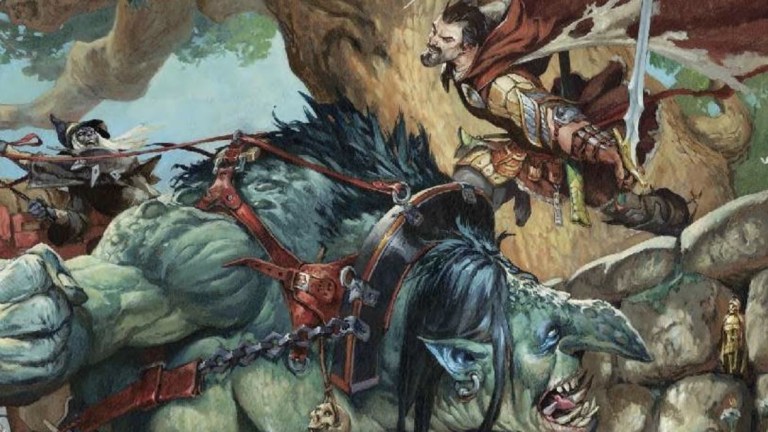Why the Forgotten Realms Is Dungeons and Dragons’ Most Beloved Setting
In the wide universe of Dungeons and Dragons, there is nowhere quite like the Forgotten Realms.

When it comes to tabletop roleplaying games, Dungeons & Dragons is the biggest name in the industry. Much of the franchise’s success can be attributed to its rich settings and lore that provide an engaging backdrop for the adventures embarked on by players and storytellers alike.
For decades, the Forgotten Realms have reigned as a fixture of pop culture. The setting has not just captivated audiences at the gaming table but reached beyond to leave its mark on novels, video games, shows, and more. This sprawling landscape with no shortage of dragons or dungeons for them to inhabit has managed to secure its place as one of the most beloved settings in the genre. But what makes it so special? What gives it that timeless appeal that keeps players coming back for more?
Memorable and Far-Reaching Characters
The Forgotten Realms boasts a roster of diverse and memorable characters that have grown from the dry-erase maps and well-worn pieces of graph paper that cover a gaming table and have since entered the cultural conversation across all forms of media. Entities like The Demogorgon, Drizzt Do’Urden, and Elminster have not only existed in novels, comics, video games, and shows but have also become touchstones in the pop culture conversation.
The Demogorgon, the terrifying two-headed Prince of Demons, is a prime example of a character whose influence extends far beyond the table. Appearing in the first edition D&D Monster Manual in 1977, Demogorgon has been one of the most memorable Forgotten Realms foes for nearly 45 years. As a monstrous embodiment of chaos and evil, Demogorgon has become an iconic figure not just within the realms themselves but also making appearances in comics, video games, and, most notably, the Netflix series Stranger Things. The presence of such a memorable menace adds a layer of familiarity to the Forgotten Realms, giving players who may have not played in the same game together the opportunity to swap stories about how their particular gaming group thwarted its vile machinations all the while drawing them deeper into the lore.
Yet, one of the most beloved characters that calls the Forgotten Realms home is the brooding and noble Drow ranger, Drizzt Do’Urden. Since 1988 Drizzt has captured the hearts of countless readers through the novels of R.A. Salvatore. His journey of self-discovery, battles against the various forces of the Underdark, and unwavering commitment to justice have made him an enduring symbol of heroism and redemption. Through his stories, the various key locations of the Forgotten Realms are explored in greater depth. Those explorations offer those familiar with the game a moment of excited recognition and those who have not yet entertained the idea of playing D&D a glimpse into a world of possibilities they could explore with pen and paper. These stories that transcend the page engage readers by enticing them to experience the same thrilling adventures in the Forgotten Realms as their beloved hero.
The Forgotten Realms also plays home to a number of characters that serve as cornerstones of the franchise’s lore. Most notably, the wizard Elminster has become the hallmark figure of arcane knowledge and lore. Created by Ed Greenwood, Elminster’s presence in numerous novels and sourcebooks has shaped the understanding of magic in the Forgotten Realms and provided players with a glimpse into the mystical mysteries that add the “sorcery” to the “Sword and Sorcery” genre. Elminster became a powerful tool of exposition allowing readers, players, and storytellers alike to learn more about the Forgotten Realms setting through his various novelized adventures. At the gaming table itself, Elminster could be activated as a non-player character controlled by Game Masters and Storytellers to act as a recognizable guide that could arrive and impart knowledge to those adding their experiences to the great tapestry of D&D lore.
Flexibility and Adaptability of Themes
Along with being an important part of the greater D&D universe, the Forgotten Realms can accommodate a wide range of themes and genres for its explorers and storytellers in ways other environments can not.
For instance, Ravenloft is a D&D setting that has its roots firmly planted in gothic horror and melancholy dread. While a skilled storyteller could weave an adventure full of high adventure full of warmth and joy, the setting, as presented, is intentional in its tone and the direction it wants players to take. The same can be said for the themes and lore of Mythic Odysseys of Theros, which asks players to wander into a world that is very much inspired by the iconography and cultures synonymous with Greek Mtyh. While many settings could be bent and manipulated to make anything possible, the Forgotten Realms readily presents opportunities for a variety of themes in its very framework.
If you are looking for epic quests, hack-and-slash dungeon crawls, or horror-filled sagas, the Forgotten Realms provides a fertile ground for storytellers and players. Their diverse collection of locations and lore can fit the tone and style that both players and storytellers are looking for.
If you are looking for epic quests in the style of classic high fantasy, the Forgotten Realms provides ample opportunity for you and your friends to stand face-to-face with ancient dragons bent on unleashing destruction upon the world. Gaming modules like “Hoard of the Dragon Queen,” where heroes face off against the Cult of the Dragon and their draconic allies, or “Princes of the Apocalypse,” where elemental cults threaten to bring about the end of the world, are just a few of the pre-written stories of epic proportions that players can find themselves engaged in.
On the other hand, Hack-and-slash dungeon crawls are perfect for players and storytellers who just want to cut loose with devastating spells and magical weapons within the Forgotten Realms. “Out of the Abyss” is an action-packed adventure that satisfies the craving for adrenaline-fueled combat and exploration, offering exciting combat challenges and fun-filled rewards at every turn.
The Forgotten Realms also has plenty of opportunities for horror-filled sagas that add a darker and more chilling atmosphere to your game nights. In settings books like “Icewind Dale: Rime of the Frostmaiden,” ancient curses, nightmarish horrors, and otherworldly forces lurking in the snow-packed shadows create an intense and suspenseful experience at the gaming table. Whether it’s investigating haunted towers or unraveling the mysteries of cursed artifacts, these horror-themed adventures provide a thrilling and memorable gaming experience.
A Rich Tapestry of Playable Characters
From dwarves to orcs, warriors to wizards, the Forgotten Realms provides many ways for players to create and embody their ideal characters. The diversity of races, classes, and backgrounds that fit in this setting allows players to fully personalize their adventures and express their creativity while feeling as if they are part of the story and not just an observer of events.
Many of the fantasy realms that have come along since the Forgotten Realms owe something to the Forgotten Realms’ use of such characters. Their interpretations of many fantasy species have been seen in (and evolved by) numerous video games, fantasy novels, and tabletop gaming systems to the point that they’ve become close to the universal standard of how certain fantasy species are depicted.
Whether you wish to embody the resilience and craftsmanship of a dwarf, the wide-eyed wonder of a gnome, a mighty warrior, a cunning rogue, or ca harming bard, the choices of class are as diverse as the players at the table. Each race brings unique cultural backgrounds, traits, and abilities to the table, allowing players to delve into the lore and weave their character’s story into the fabric of the Forgotten Realms. This ensures that players can find a character concept that resonates with them, allowing for deeper immersion and personal investment in an ancient setting that always feels like it’s designed to incorporate whatever path you walk.
Those who venture into that world are often as much of an observer of the lore as a part of the story itself. That agency and ownership of something that also feels so much bigger cement game nights as an unforgettable experience.
Easy Points of Entry
The ease of accessibility of the Forgotten Realms may be the biggest reason for its enduring popularity. Over the years there have been numerous pre-written adventures readily available for players and storytellers to explore. In the current 5th edition of Dungeons & Dragons, Wizards of the Coast continues to provide a multitude of modules that players can easily start their adventure in without feeling overwhelmed.
“The Lost Mine of Phandelver,” part of the D&D 5th edition Starter Set, serves as an excellent introductory adventure, designed for new players and storytellers. It provides a balanced mix of combat encounters, exploration, and a compelling storyline, making it a perfect starting point for those new to the Forgotten Realms setting.
“Waterdeep: Dragon Heist,” set in the bustling city of Waterdeep, presents players with a web of rival factions, intricate plots, and the opportunity to participate in a high-stakes treasure hunt. This adventure appeals to players who want to explore and learn about the culture and stories that make up the lore of the Forgotten Realms.
“Baldur’s Gate: Descent into Avernus” is another great jumping-on point to explore the mythology of the Forgotten Realms as it takes players on a journey through the dark and treacherous depths of the Nine Hells. With its blend of epic combat encounters and morally challenging decisions this offering is great for players seeking a darker and more intense campaign.
The biggest reason the Forgotten Realms has maintained its hold on popular culture is that players and storytellers, friends and family, can come together in this landscape of established lore full of diverse and memorable characters, varying themes, and constantly evolving but ever-easy points of entry time and time again to share in the hobby that is tabletop role-playing.
The setting’s ability to accommodate a wide range of storytelling styles ensures that players and storytellers can find the perfect fit for their gaming preferences. Additionally, the wealth of published adventures and the accessibility of the setting make it easy and engaging for newcomers to jump in with a low barrier of entry.
For myself and many others, the Forgotten Realms was not only an introduction to D&D fantasy and lore but a place to feel represented. Not only could I read about the adventures of Drizzt and Elminster, but I could also join in those adventures and forge memories of my own. As a disabled kid who never saw myself outside of a “very special episode,” the Forgotten Realms gave me the agency to take part in a story where I could see myself alongside everyone else at the table free of the confines and rules of my disability and limitations with only the limits of our imaginations and the stories found in our favorite comics, novels, and gaming books to guide us.
The same joy I was able to experience as a child getting lost in the varying adventures available in the Forgotten Realms continues to allow players and storytellers opportunities to embark on their own unforgettable adventures creating memories that they can then share with others in an ever-growing community. And as long as there are players seeking immersive and captivating experiences, the Forgotten Realms will continue to shine as a beloved and unforgettable setting in the realm of tabletop gaming.
